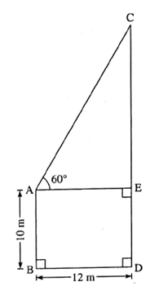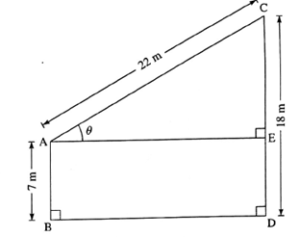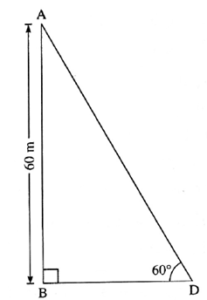Trigonometry
Class-10-Mathematics-2-Chapter-6-Maharashtra Board
Solutions-Practice Set
Question 1.1. If sin θ = \(\frac{7}{25}\), find the values of cos θ and tan θ.
Given : sin θ = \(\frac{7}{25}\)
We have,
sin2 θ + cos2 θ = 1
∴ \((\frac{7}{25})^2\) + cos2 θ = 1
∴ cos2 θ = 1 - \(\frac{49}{625}\)
∴ cos2 θ = \(\frac{625-49}{625}\) = \(\frac{576}{625}\)
∴ cos θ = \(\frac{24}{25}\) ... (Taking square roots of both the sides)
tan θ = \(\frac{sin\,θ}{cos\,θ}\) = \(\frac{7/25}{24/25}\) = \(\frac{7}{25}×\frac{25}{24}\)
∴ tan θ = \(\frac{7}{24}\)
Answer is : cos θ = \(\frac{24}{25}\), tan θ = (\frac{7}{24}\)
Question 1.2. If tan θ = \(\frac{3}{4}\) , find the values of sec θ and cos θ.
Given : tan θ =
We have,
1 + tan2 θ = sec2 θ
∴ 1 + \((\frac{3}{4})^2\) = sec2 θ
∴ 1 + \(\frac{9}{16}\) = sec2 θ
∴ \(\frac{16+9}{16}\) = sec2 θ
∴ sec2 θ = \(\frac{25}{16}\)
∴ sec θ = \(\frac{5}{4}\) ... (Taking square roots of both the sides)
cos θ = \(\frac{1}{sec\,θ}\) = \(\frac{1}{5/4}\)
∴ cos θ = \(\frac{4}{5}\)
Answer is : sec θ = \(\frac{5}{4}\), cos θ = \(\frac{4}{5}\)
Question 1.3. If cot θ = \(\frac{40}{9}\), find the values of cosec θ and sin θ.
Given : cot θ =
1 + cot2 θ = cosec2 θ
∴ 1 + \((\frac{40}{9})^2\) = cosec2 θ
∴ 1 + \(\frac{1600}{81}\) = cosec2 θ
∴ \(\frac{81+1600}{81}\) = cosec2 θ
∴ cosec2 θ = \(\frac{1681}{81}\)
∴ cosec θ = \(\frac{41}{9}\) ... (Taking square roots of both the sides)
sin θ = \(\frac{1}{cosec\,θ}\) = \(\frac{1}{41/9}\)
∴ sin θ = \(\frac{9}{41}\)
Answer is : cosec θ = \(\frac{41}{9}\) , sin θ = \(\frac{9}{41}\)
Question 1.4. If 5 sec θ – 12 cosec θ = 0, find the values of sec θ, cos θ and sin θ.
Given : 5 sec θ – 12 cosec θ = 0
∴ 5 sec θ = 12 cosec θ
∴ \(\frac{sec\,θ}{cosec\,θ}\) = \(\frac{12}{5}\)
∴ sec θ ÷ cosec θ = \(\frac{12}{5}\)
∴ \(\frac{1}{cos\,θ}÷\frac{1}{sin\,θ}\) = \(\frac{12}{5}\) ….. [∵ sec θ = \(\frac{1}{cos\,θ}\) and cosec θ = \(\frac{1}{sin\,θ}\) ]
∴ \(\frac{1}{cos\,θ}×\frac{sin\,θ}{1}\) = \(\frac{12}{5}\)
∴ \(\frac{sin\,θ}{cos\,θ} \) = \(\frac{12}{5}\) ……(1)
∴ tan θ = \(\frac{12}{5}\) ……(2)
1 + tan2 θ = sec2 θ
∴ 1 + \((\frac{12}{5})^2\) = sec2 θ
∴ 1 + \(\frac{144}{25}\) = sec2 θ
∴ \(\frac{25+144}{25}\) = sec2 θ
∴ sec2 θ = \(\frac{169}{25}\)
∴ sec θ = \(\frac{13}{5}\) ……(3) ... (Taking square roots of both the sides)
cos θ = \(\frac{1}{sec\,θ}\)
∴ cos θ = \(\frac{1}{13/5}\) = \(\frac{5}{13}\) ……(4)
\(\frac{sin\,θ}{cos\,θ} \) = \(\frac{12}{5}\) ……[From (1)]
∴ sin θ = \(\frac{12}{5}\) × cos θ = \(\frac{12}{5}\) × \(\frac{5}{13}\)
∴ sin θ = \(\frac{12}{13}\)
Answer is : sec θ = \(\frac{13}{5}\), cos θ = \(\frac{5}{13}\) and sin θ = \(\frac{12}{13}\)
Question 1.5. If tan θ = 1 then, find the values of \(\frac{sin\,θ+cos\,θ}{sec\,θ+cosec\,θ}\)
Given : tan θ = 1
We know that tan 45° = 1
∴ θ = 45°
sin θ = sin 45° = \(\frac{1}{\sqrt{2}}\)
cos θ = cos 45° = \(\frac{1}{\sqrt{2}}\)
cosec θ = cosec 45° = \(\sqrt{2}\)
\(\frac{sin\,θ+cos\,θ}{sec\,θ+cosec\,θ}\) = \(\frac{sin\,45°+cos\,45°}{sec\,45°+cosec\,45°}\)
= \(\frac{\frac{1}{\sqrt{2}}+\frac{1}{\sqrt{2}}}{\sqrt{2}+\sqrt{2}}\)
= \(\frac{(\frac{2}{\sqrt{2}})}{2\sqrt{2}}\)
= \(\frac{2}{2\sqrt{2}\sqrt{2}}\) = \(\frac{1}{2}\)
Answer is : \(\frac{sin\,θ+cos\,θ}{sec\,θ+cosec\,θ}\) = \(\frac{1}{2}\)
Question 1.6. Prove that:
(1) \(\frac{sin^2\,θ}{cos\,θ}\) + cos θ = sec θ
Proof :
LHS = \(\frac{sin^2\,θ}{cos\,θ}\) + cos θ
= \(\frac{sin^2\,θ+cos^2\,θ}{cos\,θ}\)
= \(\frac{1}{cos\,θ}\) ... (∵ sin2 θ + cos2 θ = 1)
= sec θ ... (∵ \(\frac{1}{cos\,θ}\) = sec θ )
∴ LHS = RHS
∴ \(\frac{sin^2\,θ}{cos\,θ}\) + cos θ = sec θ
(2) cos2 θ (1 + tan2 θ) = 1
Proof :
LHS = cos2 θ (1 + tan2 θ)
= cos2 θ × sec2 θ ... (∵ 1 + tan2 θ = sec2 θ )
= (cos θ x sec θ)2
= 12 ... ( ∵ cos θ x sec θ = 1)
= 1
= RHS
∴ LHS = RHS
∴ cos2 θ(1 + tan2 θ) = 1.
(3) \(\sqrt{\frac{1-sin\,θ}{1+sin\,θ}}\) = sec θ − tan θ
Proof :
LHS = \(\sqrt{\frac{1-sin\,θ}{1+sin\,θ}}\)
= \(\sqrt{\frac{1-sin\,θ}{1+sin\,θ}×\frac{1-sin\,θ}{1-sin\,θ}}\)
= \(\sqrt{\frac{(1-sin\,θ)^2}{1^2-sin^2\,θ}}\)
= \(\sqrt{\frac{(1-sin\,θ)^2}{cos^2\,θ}}\) ….[∵ sin2 θ +cos2 θ = 1, ∴ 1 - sin2 θ = cos2 θ]
= \(\frac{1-sin\,θ}{cos\,θ}\)
= \(\frac{1}{cos\,θ}-\frac{sin\,θ}{cos\,θ}\)
= sec θ − tan θ ….[∵ sec θ = \(\frac{1}{cos\,θ}\), tan θ = \(\frac{sin\,θ}{cos\,θ}\) ]
= RHS
∴ LHS = RHS
∴ \(\sqrt{\frac{1-sin\,θ}{1+sin\,θ}}\) = sec θ − tan θ
(4) (sec θ − cos θ)(cot θ + tan θ) = tan θ sec θ
Proof :
LHS = (sec θ − cos θ)(cot θ + tan θ)
We know, sec θ = \(\frac{1}{cos\,θ}\) , cot θ = \(\frac{cos\,θ}{sin\,θ}\) and tan θ = \(\frac{sin\,θ}{cos\,θ}\)
∴ LHS = \((\frac{1}{cos\,θ}-cos\,θ)\) \((\frac{cos\,θ}{sin\,θ}+\frac{sin\,θ}{cos\,θ}\)
= \((\frac{1-cos^2\,θ}{cos\,θ})\)\((\frac{cos^2\,θ+sin^2\,θ}{cos\,θ\,sin\,θ})\)
= \(\frac{sin^2\,θ}{cos\,θ}×\frac{1}{cos\,θ\,sin\,θ}\) ….[∵ sin2 θ + cos2 θ = 1, ∴ sin2 θ = 1 - cos2 θ]
= \(\frac{sin\,θ}{cos\,θ}×\frac{1}{cos\,θ}\) = tan θ × sec θ …[ ∵ \(\frac{sin\,θ}{cos\,θ}\) = tan θ and \(\frac{1}{cos\,θ}\) = sec θ]
= RHS
∴ LHS = RHS
∴ (sec θ − cos θ)(cot θ + tan θ) = tan θ sec θ
(5) cot θ + tan θ = cosec θ sec θ
Proof :
LHS = cot θ + tan θ
= \(\frac{cos\,θ}{sin\,θ}+\frac{sin\,θ}{cos\,θ}\) …[∵ cot θ = \(\frac{cos\,θ}{sin\,θ}\) and tan θ = ]
= \(\frac{cos^2\,θ+sin^2\,θ}{sin\,θ×cos\,θ}\)
= \(\frac{1}{sin\,θ×cos\,θ}\) ….[∵ sin2 θ +cos2 θ = 1]
=\(\frac{1}{sin\,θ}×\frac{1}{cos\,θ}\) = cosec θ × sec θ …[∵ \(\frac{1}{sin\,θ}\) = cosec θ and \(\frac{1}{cos\,θ}\) = sec θ]
= RHS
∴ LHS = RHS
∴ cot θ + tan θ = cosec θ sec θ
(6) \(\frac{1}{sec\,θ-tan\,θ}\) = sec θ + tan θ
Proof :
LHS = \(\frac{1}{sec\,θ-tan\,θ}\)
= \(\frac{1}{sec\,θ-tan\,θ}\) × \(\frac{sec\,θ+tan\,θ}{sec\,θ+tan\,θ}\)
= \(\frac{1(sec\,θ+tan\,θ)}{(sec\,θ-tan\,θ)(sec\,θ+tan\,θ)}\)
= \(\frac{sec\,θ+tan\,θ}{sec^\,θ-tan^\,θ}\)
= \(\frac{sec\,θ+tan\,θ}{1}\) ….[∵ 1 + tan2 θ = sec2 θ, ∴ sec2 θ - tan2 θ = 1]
= RHS
∴ LHS = RHS
∴ \(\frac{1}{sec\,θ-tan\,θ}\) = sec θ + tan θ
(7) sec4 θ − cos4 θ = 1 – 2 cos2 θ
Proof :
[Note : In the textbook the question is Prove sec4 θ − cos4 θ = 1 – 2 cos2 θ, whereas it should be sin4 θ − cos4 θ = 1 – 2 cos2 θ]
Proof :
LHS = sin4 θ − cos4 θ
= (sin2 θ) 2 - (cos2 θ) 2
= (sin2 θ + cos2 θ) (sin2 θ - cos2 θ) ... [a2 - b2 = (a + b)(a - b)]
= 1 (sin2 θ - cos2 θ) ... (∵ sin2 θ + cos2 θ = 1)
= sin2 θ - cos2 θ
= 1 - cos2 θ - cos2 θ ... [∵ sin2 θ + cos2 θ = 1. ∴ sin2 θ = 1 - cos2 θ]
= 1 - 2 cos2 θ
= RHS
∴ LHS = RHS
∴ sin4 θ − cos4 θ = 1 – 2 cos2 θ.
(8) sec θ + tan θ = \(\frac{cos\,θ}{1-sin\,θ}\)
Proof :
LHS = sec θ + tan θ
= \(\frac{1}{cos\,θ}+\frac{sin\,θ}{cos\,θ}\) …( ∵ sec θ = and tan θ = )
= \(\frac{1+sin\,θ}{cos\,θ}\)
= \(\frac{(1+sin\,θ)(1-sin\,θ)}{cos\,θ(1-sin\,θ)}\) ..[Multiplying the numerator and the denominator by (1-sin θ)]
= \(\frac{1^2-sin^2\,θ}{cos\,θ(1-sin\,θ)}\)
= \(\frac{cos^2\,θ}{cos\,θ(1-sin\,θ)}\)
= \(\frac{cos\,θ}{1-sin\,θ}\)
= RHS
∴ LHS = RHS
∴ sec θ + tan θ = \(\frac{cos\,θ}{1-sin\,θ}\)
(9) If tan θ + \(\frac{1}{tan\,θ}\) = 2 , then show that tan2 θ + \(\frac{1}{tan^2\,θ}\) = 2
tan θ + \(\frac{1}{tan\,θ}\) = 2 …(given) …(1)
Squaring both the sides, we get,
(tan θ + \(\frac{1}{tan\,θ}\))2 = (2)2
∴ tan2 θ + 2(tan θ)\(\frac{1}{tan\,θ}\) + \(\frac{1}{tan^2\,θ}\) = 4 ... [∵ (a + b)2 = a2 + 2ab + b2]
∴ tan2 θ + 2 + \(\frac{1}{tan^2\,θ}\) = 4
∴ tan2 θ + + \(\frac{1}{tan^2\,θ}\) = 4 - 2
∴ tan2 θ + + \(\frac{1}{tan^2\,θ}\) = 2
(10) \(\frac{tan\,A}{(1+tan^2\,A)^2}\) + \(\frac{cot\,A}{(1+cot^2\,A)^2}\) = sin A cos A
Proof :
LHS = \(\frac{tan\,A}{(1+tan^2\,A)^2}\) + \(\frac{cot\,A}{(1+cot^2\,A)^2}\)
= \(\frac{tan\,A}{(sec^2\,A)^2}\) + \(\frac{cot\,A}{(cosec^2\,A)^2}\) …. [∵ sec2 A = 1 + tan2 A, cosec2 A = 1 + cot2 A]
= \(\frac{tan\,A}{sec^4\,A}\) + \(\frac{cot\,A}{cosec^4\,A}\)
= (tan A ÷ sec4 A) + (cot A ÷ cosec4 A)
We know tan A = \(\frac{sin\,A}{cos\,A}\), sec A = \(\frac{1}{cos\,A}\), cot A = \(\frac{cos\,A}{sin\,A}\) and cosec A = \(\frac{1}{sin\,A}\)
∴ = \((\frac{sin\,A}{cos\,A}÷\frac{1}{cos^4\,A})\) + \((\frac{cos\,A}{sin\,A}÷\frac{1}{sin^4\,A})\)
= \((\frac{sin\,A}{cos\,A}×\frac{cos^4\,A}{1})\) + \((\frac{cos\,A}{sin\,A}×\frac{sin^4\,A}{1})\)
= sin A x cos3 A + cos A x sin3 A
= sin A x cos A (cos2 A + sin2 A)
=sin A x cos A(1) ... ( sin2 A + cos2 A = 1)
= sin A x cos A
= RHS
∴ LHS = RHS
∴ \(\frac{tan\,A}{(1+tan^2\,A)^2}\) + \(\frac{cot\,A}{(1+cot^2\,A)^2}\) = sin A cos A
(11) sec4A (1 − sin4A) − 2tan2A = 1
Proof :
LHS = sec4A (1 − sin4A) − 2tan2A
= \(\frac{1}{cos^4\,A}\) × (1 − sin2A) (1 + sin2A) - 2\(\frac{sin^2\,A}{cos^2\,A}\)
= \(\frac{1}{cos^4\,A}\) × (cos2A) (1 + sin2A) - 2\(\frac{sin^2\,A}{cos^2\,A}\) ….[∵ sin2A + cos2A = 1 ∴ 1- sin2A = cos2A]
= \(\frac{1+sin^2\,A}{cos^2\,A}-\frac{2\,sin^2\,A}{cos^2\,A}\)
= \(\frac{1+sin^2\,A-2\,sin^2\,A}{cos^2\,A}\)
= \(\frac{1-sin^2\,A}{cos^2\,A}\) = \(\frac{cos^2\,A}{cos^2\,A}\) = 1
(12) \(\frac{tan\,θ}{sec\,θ-1}\) = \(\frac{tan\,θ+sec\,θ+1}{tan\,θ+sec\,θ-1}\)
1 + tan2 θ = sec2 θ
∴ tan2 θ = sec2 θ - 1
∴ tan θ x tan θ = (sec θ + 1)(sec θ - 1)
∴ \(\frac{tan\,θ}{sec\,θ-1}\) = \(\frac{sec\,θ+1}{tan\,θ}\)
By theorem on equal ratios,
\(\frac{tan\,θ}{sec\,θ-1}\) = \(\frac{sec\,θ+1}{tan\,θ}\) = \(\frac{tan\,θ+sec\,θ+1}{sec\,θ-1+tan\,θ}\)
∴ \(\frac{tan\,θ}{sec\,θ-1}\) = \(\frac{tan\,θ+sec\,θ+1}{tan\,θ+sec\,θ-1}\)
Practice set 6.2
Question 2.1. A person is standing at a distance of 80 m from a church looking at its top. The angle of elevation is of 45°. Find the height of the church.

Let AB be the church and C be the position of the person from the church.
Suppose the height of the church AB = h m.
∠ ACB is the angle of elevation.
BC = 80 m, ∠ ACB = 45° …(given)
In right angled Δ ABC,
tan 45° = \(\frac{AB}{BC}\) = \(\frac{h}{80}\)
∴ 1 = \(\frac{h}{80}\) …( ∵ tan 45° = 1)
∴ h = 80 m
Answer is : The height of the church AB = 80 m.
Question 2.2. From the top of a lighthouse, an observer looking at a ship makes angle of depression of 60°. If the height of the lighthouse is 90 metre, then find how far the ship is from the lighthouse. ( = 1.73)

Let AB be the lighthouse and C be the position of the ship from the lighthouse.
Suppose the distance of the ship from the lighthouse be x m.
AD is the horizontal line and ∠ DAC is the angle of depression.
AB = 90 m and ∠ DAC = 60° …(given)
∠ ACB and ∠ DAC are alternate angles.
∴ ∠ ACB = ∠ DAC = 60°.
In right angle Δ ABC,
tan 60° = \(\frac{AB}{BC}\) = \(\frac{90}{x}\)
∴ \(\sqrt{3}\) = \(\frac{90}{x}\) …( ∵ tan 60° = \(\sqrt{3}\) )
∴ x = \(\frac{90}{\sqrt{3}}\) = \(\frac{90}{\sqrt{3}}×\frac{\sqrt{3}}{\sqrt{3}}\) = 30
∴ x = \(\frac{90\sqrt{3}}{3}\) = 30\(\sqrt{3}\) = 30 x 1.73 ….( \(\sqrt{3}\) = 1.73)
∴ x = 51.9 m
Answer is: The ship is at the distance of 51.9 m from the lighthouse.
Question 2.3. Two buildings are facing each other on a road of width 12 metre. From the top of the first building, which is 10 metre high, the angle of elevation of the top of the second is found to be 60°. What is the height of the second building?

Let AB and CD be two building, with
AB = 10 m
And angle of elevation from top of AB to top of CD = ∠ CAE = 60°
Width of road = BD = 12 m
Clearly, ABDE is a rectangle
With
AB = ED = 10 m
BD = AE = 12 m
And AEC is a right-angled triangle, In Δ AEC
tan 60° = \(\frac{CE}{AE}\) ...(By definition)
∴ \(\sqrt{3}\) = \(\frac{CE}{12}\)
∴ CE = 12\(\sqrt{3}\) m
Also,
CD = CE + ED = (12\(\sqrt{3}\) + 10) m
Hence, height of other building is (12\(\sqrt{3}\) + 10 m).
Question 2.4. Two poles of heights 18 metre and 7 metre are erected on a ground. The length of the wire fastened at their tops in 22 metre. Find the angle made by the wire with the horizontal.

Let seg AB and seg CD represent the two poles.
AC represents the wire and seg AE ⊥ seg CD ... C-E-D.
AB =7 m, CD = 18 m, AC = 22 m.
∠ CAE is the angle made by the wire with the horizontal.
Let ∠ CAE = θ.
□ ABDE is a rectangle.
DE = AB = 7 m ... (Opposite sides of rectangle are equal)
CE + ED = CD ... (C-E-D)
∴ CE + 7 = 18
∴ CE = 18 - 7
∴ CE = 11 m
In right angled Δ CEA,
sin θ = \(\frac{CE}{AC}\) ... (By definition)
∴ sin θ = \(\frac{11}{22}\) = \(\frac{1}{2}\)
We know that, sin 30° = \(\frac{1}{2}\)
∴ θ = 30°
Answer is: The angle made by the wire with the horizontal is 30°.
Question 2.5. A storm broke a tree and the treetop rested 20 m from the base of the tree, making an angle of 60° with the horizontal. Find the height of the tree.

Let seg AB represent the tree before the storm.
Due to storm, tree gets broken at C. Broken part AC takes the position CD.
∴ AC = CD ….(1)
BD = 20 m and ∠ CDB = 60°
In right angled Δ CBD,
tan 60° = \(\frac{CB}{BD}\) ……(By definition)
∴ \(\sqrt{3}\) = \(\frac{CB}{20}\) ………(tan 60° = \(\sqrt{3}\) )
CB = 20\(\sqrt{3}\) m
Also sin 60° = \(\frac{CB}{CD}\) …..(By definitlon)
∴ \(\frac{\sqrt{3}}{2}\) = \(\frac{20\sqrt{3}}{CD}\) ………(sin 60° = )
∴ CD = \(\frac{2×20\sqrt{3}}{\sqrt{3}}\)
∴ CD = 40 m
AC = CD = 40m …..[From(1)]
AB = AC + CB …..(A-C-B)
∴ AB = (40 + 20\(\sqrt{3}\)) m
Answer is : The height of the tree is (40 + 20\(\sqrt{3}\) ) m
Question 2.6. A kite is flying at a height of 60 m above the ground. The string attached to the kite is tied at the ground. It makes an angle of 60° with the ground. Assuming that the string is straight, find the length of the string. ( = 1.73)

Let A represent the position of kite.
seg BD represent the surface of the ground.
seg AB is the height of the kite above the ground.
AB = 60 m.
AD represents the string.
∠ ADB is the angle made by the string with the ground.
∠ ADB = 60°
In right angled Δ ABD,
sin 60° = \(\frac{AB}{AD}\) ….(By definition)
∴ \(\frac{\sqrt{3}}{2}\) = \(\frac{60}{AD}\) ………(sin 60° = \(\frac{\sqrt{3}}{2}\))
∴ AD × \(\sqrt{3}\) = 60 × 2
∴ AD = \(\frac{60×2}{\sqrt{3}}\) = \(\frac{120×\sqrt{3}}{\sqrt{3}×\sqrt{3}}\) = \(\frac{120×\sqrt{3}}{3}\)
AD = 40\(\sqrt{3}\)
∴ AD = 40 x 1.73 ….(∵ \(\sqrt{3}\) = 1.732)
∴ AD = 69.2 m
Answer is : The length of the string is 69.2 m.
PDF-Notes,Solution,Text Book
Main Page : – Maharashtra Board Class 10th-Mathematics – All chapters notes, solutions, videos, test, pdf.
Previous Chapter : Chapter-5-Co-ordinate Geometry – Online Solutions
Next Chapter : Chapter-7-Mensuration – Online Notes
We reply to valid query.